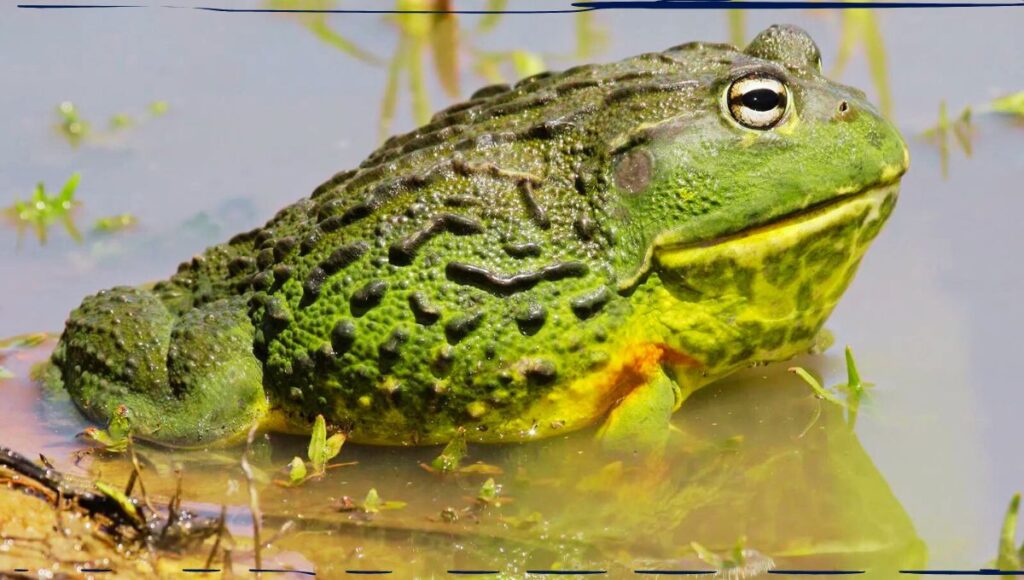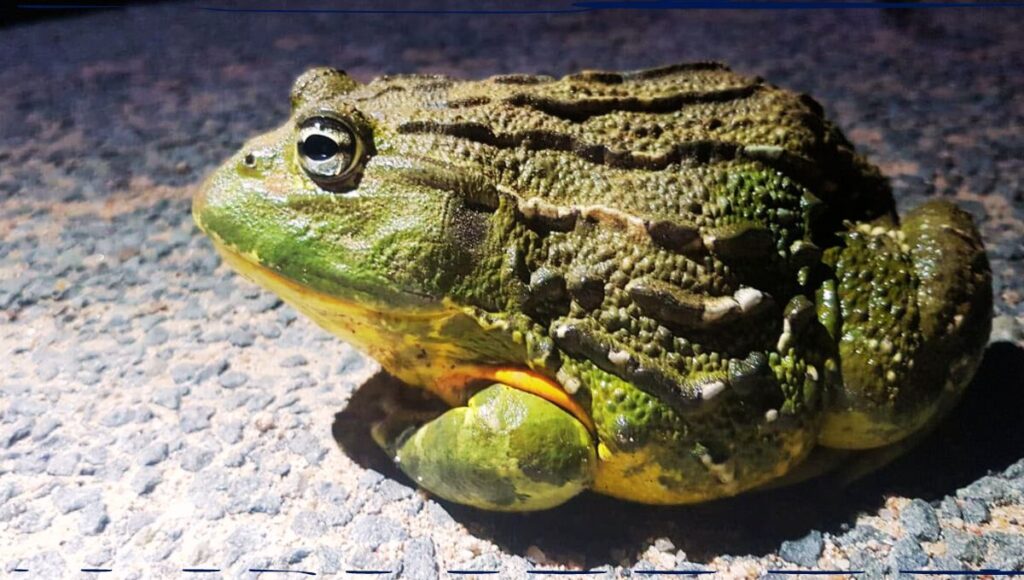The Pixie frog, African Bullfrog, Giant bullfrog, or the South African burrowing frog has often been confused with the edible bullfrog. Still, the two species have distinct differences between them. Let’s dive into the world of the Pixie Frog and explore the unknown secrets about them.

Table of Contents
Everything You Should Know About Pixie Frog (African Bullfrog) Before Purchasing:
In a Glimpse:
| Common Name | African Bullfrog |
| Scientific Name | Pyxicephalus adspersus |
| Other Names | Pixie Frog, Giant bullfrog, South African burrowing frog |
| Maximum Length | 9.6 in |
| Maximum Weight | 3.5 lbs |
| Ranges | Southern Part of African Continent |
| Habitat | Shrubland, freshwater lakes, ponds, marshes, etc. |
| Diet | Carnivore |
| IUCN Status | Least Concern |
| Lifespan | 20-25 years |
Geographical Range:

The Pixie or African Bullfrogs are generally found in the south of the African continent. Especially in Angola, South Africa, Botswana, Kenya, Malawi, Tanzania, Uganda, Zambia, Zimbabwe, Mozambique, Namibia, and Congo. However, the frog species is extirpated from Eswatini.
Habitat:

The natural habitats for South African burrowing frogs or Pixie Frogs are moist to dry savanna, subtropical or tropical shrubland, freshwater lakes, marshes, arable land, pastureland, canals, and flooded ditches.
Despite being amphibians, African Bullfrogs can live without water for a long time. They can live in mountains, sands, and rocky surfaces but humid conditions with water are best suitable for them. The frogs often dig chambers in the soil when the weather is too harsh and only come out when the situation is favourable. During the dormant condition, they form a cocoon, which covers the entire body surface except the external nostrils. The cocoons help to decrease the rate of evaporation and when it rains the frogs again crawl out in nature.
Physical Descriptions:
African Bullfrogs are among one of the biggest frogs in the world. They are the largest anurans in the world and the sixth largest frog species just after the goliath frog, helmeted water toad, the Lake Junin frog, the Blyth’s river frog, and the cane toad.
How do you identify a Pixie frog or African Bullfrog?

Sexual dimorphism is present among Pixie frogs and unlike other frog species, females are half the size of the males. Usually, The female frogs in other frog species are larger than the males. A male African Bullfrog can be as big as a dinner plate and is olive green with yellow/orange shades in the throat.
On the contrary, the females are much smaller compared to the males and olive green or light brown with a white/ cream colour throat. Younger toads are brightly coloured with mottled skin and yellow lines that run down their back.
The Pixie frogs have huge skulls, robust skeletons, and muscular legs that help to jump away from predators. Their skins are full of glands that help to protect the internal organs, taking oxygen and absorbing water.
African Bullfrog is one of the three frog species that have teeth. However, they are not actual teeth but their bottom jaw has three structures called odontodes. These odontodes grow with maturity and look similar to teeth but grow on the top of the skin.
Measurements:
The male African Bullfrogs weigh up to 1.4 kg- 1.6 kg (3.1-3.5 lbs) whereas the females usually weigh around 1.5 lbs or 0.7 kg. A male Pixie frog can grow up to 24.5 cm (9.6 in) in snout–to–vent length.
Lifespan:
African Bullfrogs can live up to 20-25 years in the wild but in captivity, they can live up to 35-45 years.
Diets:
The Pixie frogs are carnivorous and they feed on insects and other invertebrates, small rodents, fish, small birds, and other amphibians whatever fits in their mouth. The male bullfrog can also show cannibalistic behaviour as they often eat the tadpoles they guard.
The frogs are prone to consume whatever they find nearby. Hence, if you are planning to purchase an African Bullfrog, ensure that there is no indigestible object is present within their reach, such as toys, papers, ground beef, etc.
Predators:
Their natural predators consist of larger prey birds, snakes, monitor lizards, and turtles.
Disease:
Like other frog species, Pixie frogs are subjected to diseases such as chytridiomycosis (a skin disease) and other diseases caused by ranaviruses. If their maintenance at home is neglected, the frogs can be subjected to skin infections, eyes, and ammonia poisoning.
Conservation Status:
African Bullfrogs are listed as “Least Concern” in the IUCN Red List of Threatened Species.
Pixie Frogs/ African Bullfrogs as a Pet:

The Pixie frogs are considered exotic pets in various countries around the world. But if you want a cuddly pet, then perhaps it is not the best option for you. The frogs don’t like to be touched or handled by humans. They can bite and harm the handlers.
Hence, if you plan to buy a pet to play with, African Bullfrogs are not the best option for you. But the frogs can be very entertaining to watch due to their appearance. However, if you are a new frog owner, you can purchase the frog because the Pixie frogs are very easygoing and low-maintenance in terms of their care. Be careful if you have other small pets at your home, such as small birds, butterflies, or other frogs, then the bullfrog might kill them.
Requirements:
The Pet African Bullfrog must be kept in a tank that is at least 10 gallons large and receives 12 hours of light and 12 hours of darkness every day. The container or tank should be kept at 75 degrees Fahrenheit or 24 degrees Celsius with a maintained 80-90% humidity level.
You can use small and smooth rocks at the bottom of the tank and fill the tank one-third with dechlorinated water. You should use larger stones to build up the sides of the tank so the frog can easily climb onto and dry off when they want to. You can clean the tank once or twice a week to keep the water fresh.
How do you buy a Pixie Frog?
The frog species is quite popular around the world; you can find it at your nearby pet shops or rescue organizations. However, it is advisable to purchase the frog from a reputed frog breeder. If you don’t find a reputed breeder in your locality, you can check out the internet and find a reputed breeder easily. Depending on your location, the price may vary but you can expect to pay around $35-$100 for a good quality African Bullfrog or Pixie Frog.
Are African and Edible Bullfrogs the same species?
However, African and Edible bullfrogs are closely related but they are two different species. Let’s have a look at their differences:
| Criteria | African Bullfrog | Edible Bullfrog |
| Size | Much larger (Weighs around 3-3.5 lbs and 9-10 in long). | Much Smaller (Weighs around 2 lbs and 3-4.5 in long). |
| Habitat | Much Smaller (Weighs around 2 lbs and is 3-4.5 in long). | Found in marshy areas but sand and clay substrates are their preference. |
| Scientific Name | Pyxicephalus adspersus | Pyxicephalus edulis |
| Appearance | Males are Yellow-green to Olive Green and Females Olive Brown. | Males are Olive Green and Females are Light Brown. |
| Teeth | Three tooth-like structures are found. | Two tooth-like structures are found |
| Availability | Easier to find in the international pet trade. | Difficult to find in the international pet trade. |
Reference: Wikipedia
FAQs:
Is African Bullfrog poisonous?
Unlike American Bullfrogs, African Bullfrogs are not poisonous. They don’t secrete any poison from their skins or glands. Instead, they have a very fierce bite (due to their strong jaw and odontodes) that works as a defence against a predator. In Namibia, the bullfrogs are considered as a delicacy.
Why are the African Bullfrogs known as Pixie frogs?
The scientific name of the African Bullfrog is Pyxicephalus adspersus and due to its scientific name, the frog species is also known as the Pixie frog.
Are African Bullfrogs invasive?
The African Bullfrogs are carnivorous and they eat almost everything that fits into their mouth. The frogs even show a cannibalistic nature which means they consume their own species.
The frogs are not invasive in their natural habitat but if they are introduced to any other environment, they can show invasive nature due to their voracious diet. However, these bullfrogs are not banned in many countries like American Bullfrogs but due to their similarities, it can be guessed that African Bullfrogs can also become invasive.
Are African Bullfrogs rare?
In the IUCN Red List of Threatened Species, the frogs are listed as “Least Concern” as their population is increasing rapidly. But in South Africa, the population of these Bullfrogs (especially in the wild) is constantly decreasing due to habitat loss outside of specially protected areas and it is a big concern to the species.
Are African Bullfrogs Aggressive? Can you keep 2 frogs in the same tank?
African (Pixie frogs) Bullfrogs are very aggressive and often show territorial aggression. They inflate their body and attack the intruder with its huge mouth agape. Also, the frogs are solitary by nature (except during breeding season) show a cannibalistic nature, and consume their own species. Hence, it is not a good idea to keep two African Bullfrogs together in the same tank, otherwise, they’ll fight and the winner will consume the loser.
Does the bite of an African Bullfrog hurt?
Yes, the African Bullfrogs have a very strong bite and their bite can be very painful.
Is Pixie Frog friendly to humans?
Pixie frogs are not cuddly pets and are known for their bad temper. The frogs don’t like human touch and it might cause stress to them. If you want to make them friends, just feed them with soft-tipped feeding tongs. Don’t touch them if it is not very necessary. If you annoy the Pixie frogs, they might bite you too and it’ll be very painful.
Is it Safe to Pick Up an African Bullfrog?
Unlike American Bullfrogs, African Bullfrogs don’t secrete any poison and hence it is safe to pick up the frog with bare hands. However, it is recommended to wear nitrile gloves before touching them and wash your hands before and after touching the frog.
Is African Bullfrog poisonous for dogs?
No, as Pixie frogs don’t secrete any toxic substances, they are not harmful to dogs. But if the frogs bite a dog, it might cause serious injury to the dog.
Also Read:
Is American Bullfrog Banned as Pet? 11 Differences with African Bullfrog